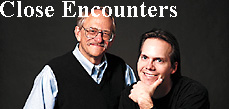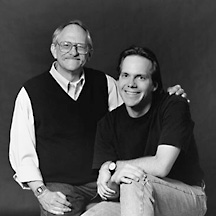

With these opportunities to discover and disseminate knowledge come the special relationships between professors and their students.
One person who benefited from a personal relationship was Mike Hutnak. He had come to the UW after attending Washington State University for three years before running out of money. "Typical college gig," he says. "It was the Reagan era. I couldn't get any more financial aid, and my choices were either to work and save my money for school or work full-time and go to school full-time. I decided to work."
For five years, he ran pizza joints in Pullman and Moscow, Idaho. When he saved up enough money, he decided he had tired of studying biology at WSU, and came to the UW in 1994 to try his hand at geological oceanography. When he heard that Oceanography Professor H. Paul Johnson needed help in his lab, Hutnak, a junior, jumped at it, even though he had little experience in the field.

Right from the start, he got involved in some of Johnson's biggest projects funded by the National Science Foundation, including trying to measure heat flow in ocean sediments. Hutnak was no "test-tube washer." He single-handedly devised and built an instrument made out of nylon, padding and electronic thermometers that measured both sea temperature and heat emanating from the ocean floor's rock surface.
"I just turned him loose," says Johnson. "He did all the design, construction and testing, and was so successful, the Japanese asked him to build one for them. And he did."
The success of the project -- funded by a special NSF Small Grant for Exploratory Research for "crazy ideas," Johnson says -- could lead to a follow-up $1 million grant.
Hutnak's work helped record the first-ever measurements of heat coming from bare rocks near seafloor volcanoes. Scientists are using this data to create computer models of the heat coming from deep within the Earth.
"At first, I felt in over my head," recalls Hutnak. "Grad students have sound footing on theory and a background of looking at a particular problem. They are also taught to think in a different way. But I was able to come into Paul's office at any time to ask questions, go over things, go get a bite and work things out."
Why was such a respected oceanographer so open to working with a junior with no background in the field? "I don't work well talking to myself," Johnson says. "Students here are not passive receptors. They make major contributions. This is not a government or industrial lab, after all. And he had the initiative and maturity to make it happen. I found that inspiring, and I learned a lot from him."
Hutnak, who received his bachelor's degree in 1996, is still around. Shortly after graduation, he was hired as a technician in Johnson's lab, despite his lack of graduate training. "The support and encouragement I got from Paul and the department is what got me here," Hutnak says. "We worked almost as peers, on the same level. I am given very important tasks, even ones I don't know completely. I take it upon myself to learn a computer program, for example, and see how it fits into our projects."
Li-wei He, a 22-year-old native of China, had the same undergraduate experience in computer science. "Usually undergraduates are hired to do simple programming, but we have helped lead the research," says He, who helped Salesin and Michael Cohen at Microsoft Research develop "virtual cinematography software." The program provides movie-like video representations of on-line chat worlds in real time.
Partially Sighted Student Is Valued Member of Botany Research Team
Send a letter to the editor at columns@u.washington.edu.